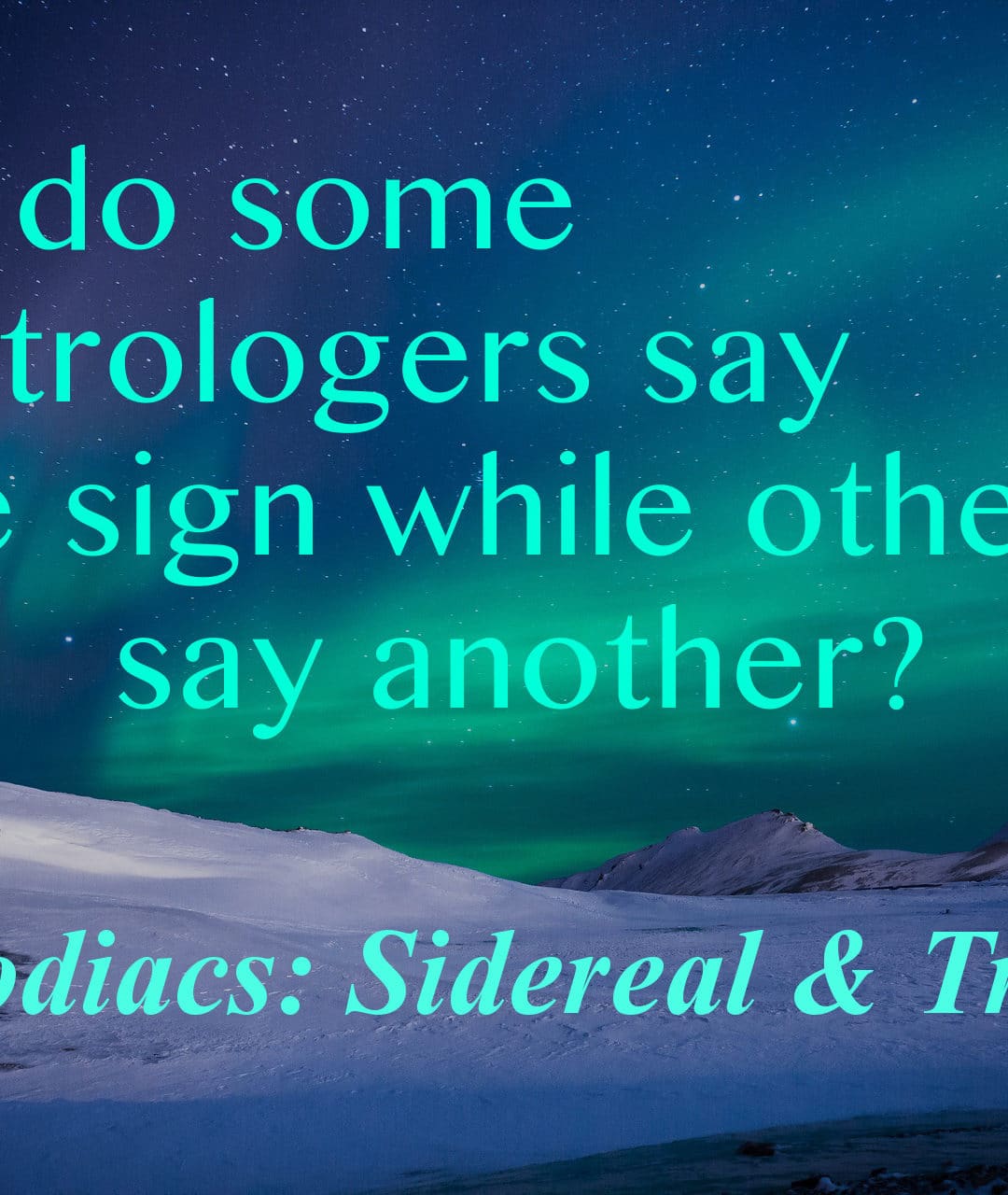
by Somya Devi | Oct 5, 2017 | Astrology
Two Zodiacs by Somya Devi
Almost every month I get a few responses to my blog or newsletter with people telling me I have gotten it wrong stating where the full Moon is. “It’s not in Pisces, it’s in Aries! That’s what my moon calendar says and that’s what all the other astrologers say.” What people don’t realize is that I am using the astronomical zodiac, while most Western astrologers use a different zodiacal system, one that does not line up with what we see in the sky.
I approach astrology from the Vedic tradition, called Jyotish, “the science of light,” commonly called Vedic or Hindu astrology. Most Vedic astrologers, myself included, use the sidereal, “star-based” zodiac, for calculating where the planets are. A zodiac is a system, or set of reference points, for locating where things are in the sky. It’s not simply the twelve constellations as we see them. The sidereal zodiac is the zodiac that correlates most closely with how we actually see the stars and planets in the sky from Earth. Western astrologers, who get a lot more press, generally use the tropical zodiac as a reference system. This is a different celestial measurement system, with reference points based on the seasons, not on how we see the planets and constellations from Earth.
For example, when I wrote that we’re experiencing a full Moon in Pisces today (Oct. 5, 2017), some people write to me and say “no, it’s in Aries!” That is what Western astrologers (and many popular calendars), will tell you, basing their calculations for the Moon on the tropical zodiac. But you can look at this astronomy-app screenshot from right now (or look at the sky, tonight) and see that the Moon is actually still aligned with Pisces, from our perspective here on Earth. You can compare this astronomical image to the Vedic and Western charts for today, below. Check out this online planetarium that will show you what is overhead in the sky right now, or at a given time. Makes it easy to see what I’m talking about!
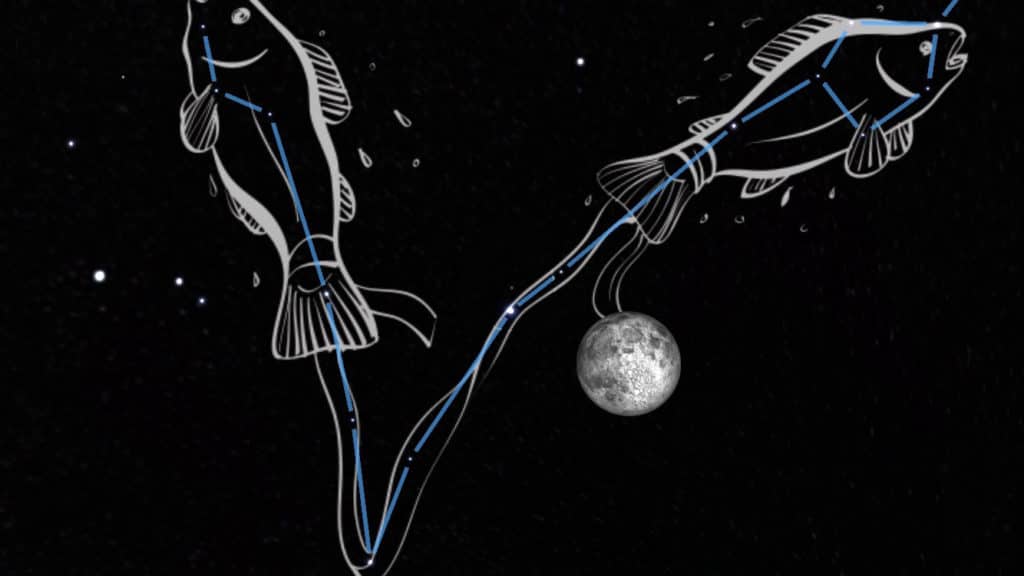
SkyView Free app, Screenshot from October 5, 2017
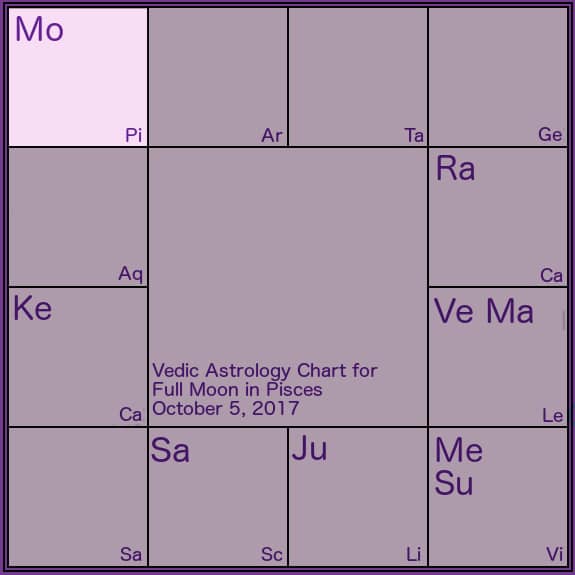
Sidereal Vedic chart 10/5/17
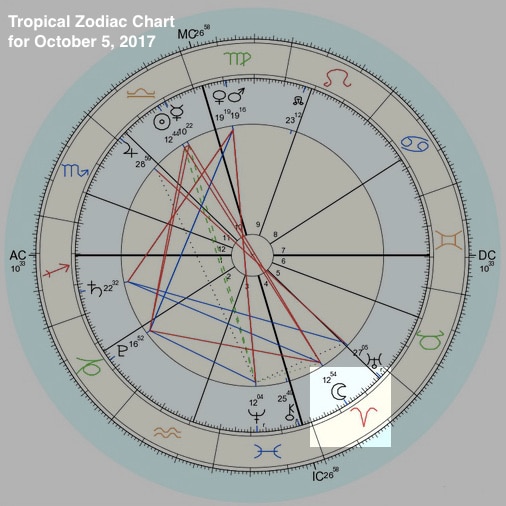
Tropical Zodiac chart for 10/5/17
If you live in a place where you can see the stars against the backdrop of the full Moon, I also encourage you to go outside and look at the sky and identify the constellations tonight, and on each full Moon, and you will see what Vedic astrologers are talking about. After all, astrology originated from star-gazers paying attention to the patterns that came with the movement of the stars and planets (called gola, or observation, in Jyotish).
So, what happened? A few thousand years ago, the two zodiacs lined up. All astrologers and astronomers could calculate that the Sun entered Aries’ part of the sky around March 21st, the spring equinox (hence this became the common zero-degree starting point of the zodiac).
Because of the wobble of the earth, however, over time the perspective from earth has shifted. The location of the fixed stars behind Sun on the equinox (or any other day), actually shifts eastward about one whole zodiac degree every 72 years. That is to say, if you could see the Sun and the stars simultaneously on March 21st of this year (or if you study a modern astronomical calculation), you would see that the Sun is near the beginning (approx. 7°) of sidereal Pisces on the spring equinox:
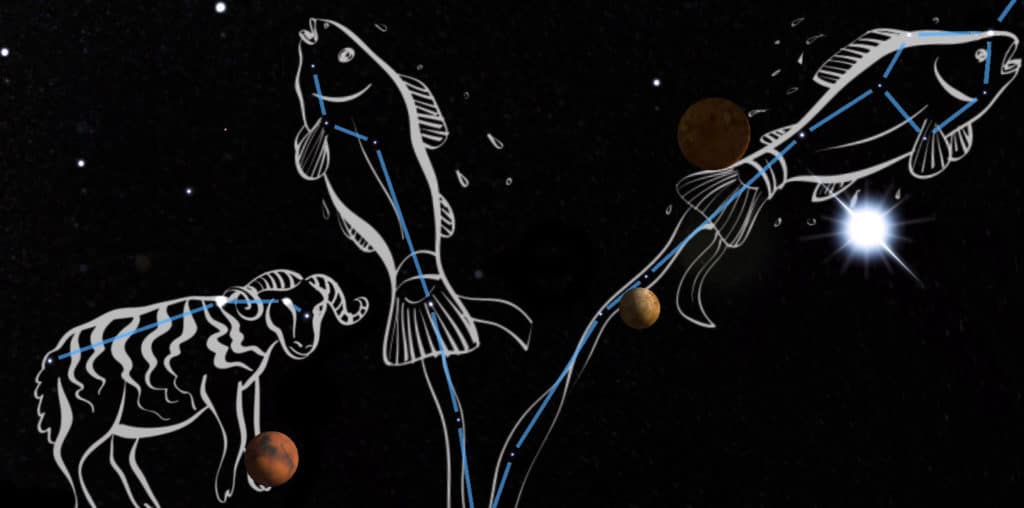
SkyView Free app, Screenshot from March 21, 2017 (bright white orb represents the Sun, Pisces and Aries constellations to the east)
The Western school of astrology at some point decided to “fix” the tropical zodiac, so that what they call “Aries (the zodiac sign)” is the first 30° longitude of the sky that the Sun traverses, beginning on the spring equinox, regardless of its relationship to the fixed stars of the constellation Aries that we see in the sky. Hence, wherever the Sun aligns on the spring equinox, that part of the sky will be designated as 0° Tropical Aries, even though it does not align with the visible constellation of Aries. Because the fixed stars have been slowly shifting over thousands of years (often called the “precession of the equinoxes”, the Sun does not align with the constellation of Aries until mid-April in modern times.
To simplify the difference between the zodiacs, the sidereal zodiac and the tropical zodiac are currently around 23° of a sign apart. Planets in a sidereal chart will be around 23° of a sign behind where they are in a tropical chart (so about ¾ of the time they will be in the previous sign). Most Vedic astrologers use the sidereal zodiac while most Western astrologers use the tropical.
Because the fixed-stars zodiac is shifting “backwards” each year, and the Sun on the vernal equinox is now at 7° Pisces, and all of the planets in a Vedic chart are measured as being about 23° behind where they are in a Western chart (about ¾ of a sign behind). As a result of this, about ¾ of the time, Vedic astrologers will cite a Full Moon, or the rising sign and any planet in your birth chart, as being in a different sign than what you have commonly heard from the more mainstream Western/tropical perspective.
This is very interesting when you look at your natal chart, because about ¾ of your planets will be in different signs in your Vedic chart than they were in your Western. The Sun does not transit through sidereal Aries from March 21st to April 20th, but from April 13th through May 14th. The Vedic sidereal natal chart is a representation of the astronomical map at the time of your birth. It shows where one could have identified the planets and stars through observation of the night sky. For example, your Western tropical chart may indicate that you are “Libra rising,” but your Vedic chart may show Virgo rising, meaning that if you were born at night and had looked straight out on the eastern horizon at the time of your birth, you could have actually identified the constellation Virgo rising in the sky (if it were a nighttime birth).
These are the dates that the Sun aligns with the 30° segments of the sidereal zodiac, which is closely aligned with the measurable/observable astronomical alignment of the Sun and these constellations in the sky (save for the varying breadth of the constellations, see end of article):
Aries: April 13th – May 14th
Taurus: May 14th – June 14th
Gemini: June 14th – July 16th
Cancer: July 16th – August 15th
Leo: August 15th – September 16th
Virgo: September 16th – October 15th
Libra: October 15th – November 15th
Scorpio: November 15th – December 15th
Sagittarius: December 15th – January 13th
Capricorn: January 13th – February 12th
Aquarius: February 12th – March 13th
Pisces: March 13th – April 13th
Dates may vary by a day or two from year to year. You can also see that I have listed the signs with overlapping dates. That is because the Sun does not pass the imaginary 0° mark of a sign at exactly midnight each month. If you were born on one of these cusp days, you would want to review your Vedic astrological chart to see which sign the Sun was technically transiting during your birth. You will also want to discuss with your astrologer what it means for you to have your Sun so closely on the cusp of two signs.
It is also very important to note that in a Vedic astrology natal chart reading, most Vedic astrologers would not identify you as a “[your Vedic Sun sign, above].” Rather, we generally look at your Vedic rising sign, the constellation that was coming up on the eastern horizon at your birth time, as your most prominent energy. This is the one that most influences your personality, physical body, and everyday experience. The rising sign changes every couple of hours each day, so this helps us to get much more specific about your individual makeup, rather than grouping everyone born during the same month of the year together. The rising sign also determines where all twelve houses in your chart overlap with the twelve major constellations, telling us more about your style in each area of life. (For example, everyone with Libra rising has Aries for their house of relationships, and Cancer for their house of Career.) Of course, understanding the placement of all the planets in the birth chart will give us the best understanding of your make-up, as there are many factors that can add a lot of influence to your life.
Another notable point that you can see in the screenshot above, is that some of the constellations take up far more space in the sky than others (see Aries vs. Pisces, above). The twelve major zodiacal constellations are the ones in the same band of the sky where we see the Sun and Moon rise and set each day, called the ecliptic. (Each of these major constellations also rises and sets each day.) Hence, the “circle” of the ecliptic is mathematically divided into 360°. At some point, there were designated twelve equal 30° sections, for ease of identification. Each of the twelve major signs “gets” exactly 30° of the ecliptic, even though the constellations themselves may fill slightly more or less than that distance of visible arc.
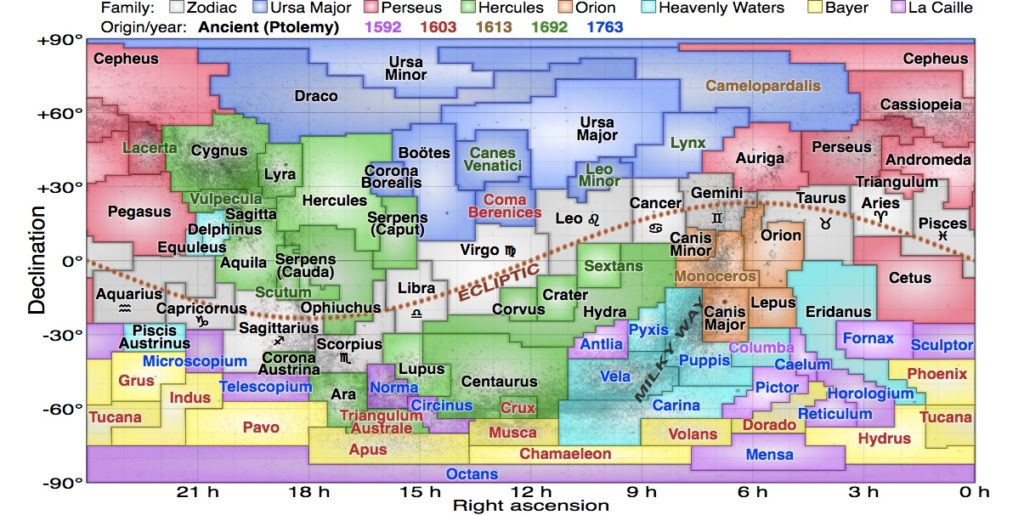
Wikipedia image
So, please don’t be surprised or think that an astrologer has made an error if you see them writing about a Full Moon that is one sign off from what you have heard others say. Take note of which astrologers are using the sidereal vs. the tropical zodiac (some Western astrologers also use the sidereal zodiac, and a few Vedic astrologers use the tropical).
Get to know both your Vedic and Western charts to see the differences, and feel into what resonates more for you. Usually both do to some degree, but many people breathe a sigh of relief when they finally learn about their Vedic chart, because it often makes a lot more sense, resonates on a deeper level, and reveals more about their being. Above all, don’t just take the word of any astrologer, but go out in the night sky and observe the stars and planets for yourself! Feel into them and begin to interpret your own astrology, because astrology is inherently an observation of astronomy, and how the movement of the stars and planets relate with us, physically, energetically, emotionally, and spiritually.
I hope that helps! Thank you for your interest. I love educating people about the two different zodiacs and the wisdom of Vedic astrology … I would love to work with you through a personal Vedic astrology chart reading to share insights on your personal sidereal natal chart, and what it illuminates about your personality, karma, and life course.
I have tried to simplify this topic to give readers a basic understanding of the difference between these two zodiacs and astrological perspectives. One can go into much deeper research about the origins and subtleties of these and their use/preference by astrologers (there is much debate on the topic, and I am a perpetual student myself). Here are a few articles from colleagues and public sources that begin to dive deeper into this topic. Please feel free to send me other links you think would be useful here:
Wikipedia article on Zodiacs
Wikipedia article on Axial Precession
Story of the Zodiac Vedic Astrology by Sam Geppi
Vedic Astrology and the Sidereal Zodiac in the Age of Misinformation by Sam Geppi
The Tale of Two Zodiacs by Freedom Cole
Save
Save
Save
Save
Save
Save
Save
Save
Save
Save
Save
Save
Save
Save
Save
Save
Save
Save
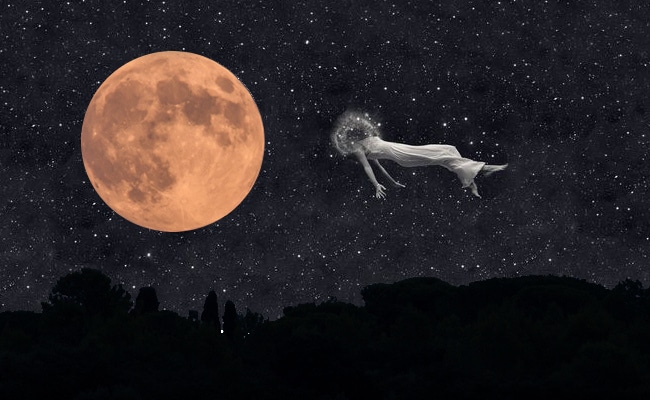
by Somya Devi | Oct 4, 2017 | Astrology
The full Moon in sidereal Pisces peaks tomorrow morning at 11:40 am (PDT), and aligns with the very last of the 27 Vedic nakshatras, Revati. This energy brings forth a wave of open-hearted surrender and ushers us to let go of everything from the past season, as we enter the dark and inward months of the year.
Harvest Moon
The full Moon falling closest to the autumnal equinox (September 22nd), is known as the Harvest Moon. For farmers this has traditionally been an optimal time to harvest the crops of the season, not only because of their readiness, but because of the bright and glowing Moon that appears in the evenings at this time. During this time of year, close to the equinox, the time of the moonrise is very close to the time of the sunset (moonrise today is at 6:36 pm PDT, and tomorrow at 7:11, while sunset is at 6:47 today and 6:46 tomorrow). The Moon looks the largest around its rising and setting times, because of the way light refracts through the lower portions of the atmosphere, and when it occurs near to sunset, the Moon will catch the bright orange sunset rays and take on a hearty glow.
Pisces Full Moon
It is apt that at this time of year the full Moon is also in Pisces, the last of the twelve major zodiac signs, and Revati, the last of the 27 Vedic signs, both of which elicit imagery of closing a chapter. Pisces, an introverted water-sign ruled by Jupiter, opens the depths of our emotional bodies and calls us to connect them with our higher belief systems. It is a sign of surrender, where we let go of material attachments, and even the material world at times, and allow ourselves to give in totally to spirit and divine flow. It is a powerful sign for meditation, dreamwork, and inward journeys. It can also invoke an energy of escapism, so be careful not to go down any rabbit holes unconsciously.
The Pisces full Moon illuminates the contrasting energy to Virgo, where we began this lunar cycle on the New Moon of September 19th. Virgo is a grounded and practical earth-sign, ruled by Mercury, the planet of the intellect. Virgo energy compelled us to get our ducks in a row, do the final accounting of the season and make sure we have things neatly squirreled away before the change of seasons. Pisces’ energy reminds us that we can’t account for or control everything, and at the final moments of our outward effort, we can only surrender to divine will to carry us the rest of the way.
Revati Nakshatra
Revati, the nakshatra where this full Moon falls, is a star of journeys. We can see this ultimately as the journey to the other side, if the progression of energy through the signs is symbolic of our progression through life. The last and final nakshatra begs us to let go of all efforts and worldly attachments as we merge into the infinite, ultimately giving up even this waking life. We can still apply this metaphor while embodied, however, by loosening our grip on the striving to be in control, and dissolving into the sea of divine light.
Revati is translated as “the wealthy” and is ruled by Pushan, the deity of nourishment as well as journeys. He is often depicted standing at the beginning (or end) of a path and can be seen as a celestial shepherd, ushering us safely along the many roads through life, and beyond. People born under Revati nakshatra tend to have a very kind and loving disposition, and a distinct affection for animals. Though it is a star of wealth, there is an incredibly generous nature here, reflecting abundant spiritual wealth as well as material is possible.
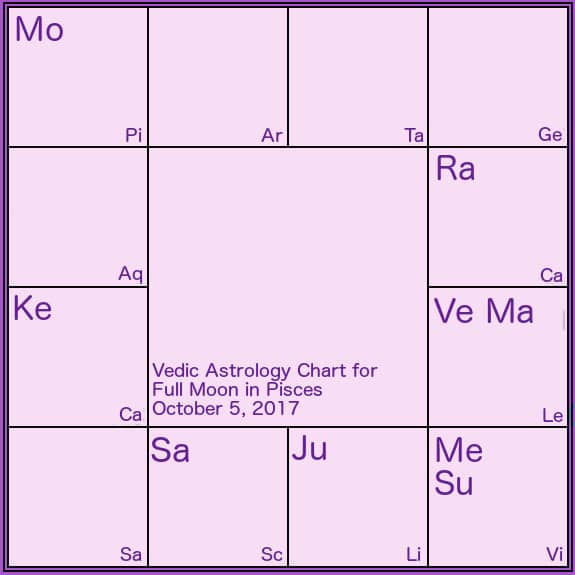
Venus and Mars
Venus and Mars remain tightly aligned, around 25 degrees of sidereal Leo, engaging in a planetary war this week (from Tuesday through Saturday). It is as if the forces of Mars and Venus are fighting for dominance within us. Our desires and relationships may feel at odds with our ability to exert strength an a strong will at the moment. Venus’ energy is probably winning out (more giving in to desires, less willingness to fight), both because of his brightness over Mars and because the full Moon is in Venus’ sign of exaltation (Revati). Desires can seem heightened with Venus in Leo, as they take their seat on the throne and their importance is temporarily amplified.
Venus will soon transit into Virgo, however, his sign of debilitation, where we’ll become much more analytical over our desires as well as relationships. With Venus currently in Leo, we can tend to relate our power with these things, but once he transits into Virgo, we’re likely to become much more grounded and practical. It will be an interesting experience, after Venus was exalted in Pisces, the opposite sign, for four months earlier during this year. The high that we may have experienced then will finally come down to a place we will be looking at our relationships and desires through a very intellectual lens.
Enjoy the powerful medicine of this Pisces full Moon, which has the potential to open our hearts and deepen our surrender. Magic, mysticism, and meditation are easily accessible, so be sure to spend some time going inward and feel what arises.
Om Namah Sivaya
Save
Save
Save

by Somya Devi | Sep 20, 2017 | Astrology, Events, Holy Days
Maha Navaratri 2017 begins today! In this important Hindu holiday, we celebrate the Goddess through “the great nine nights” (nav = nine, ratri = night). This festival will run through September 30th, the first ten days of this new lunar cycle. Goddess, Devi, Shakti, Durga, Divine Mother—the many names and forms all represent the dynamic and fluid feminine power that enlivens all of existence.
She is the creatrix, the warrioress, the nurturer, the purifyer, the protector. While she’s in the innocent and fertile maiden so is she the wise and learned crone. Both the nurturing mother, and the one who gives “tough love.” The impassioned lover, the devoted bhakta, the disciplined yogini. We see Goddess appear through us in innumerable manifestations. Through her many forms she teaches us and offers us countless blessings–love, compassion, courage, learning, discipline, surrender, success, enlightenment, and bliss. This festival is a time for celebrating the supreme feminine power in all her glory, and the many blessings she bestows upon us.
As with most Hindu celebrations, this festival correlates with the lunar calendar, and thus begins on the first day of the waxing Moon after the New Moon of September 19th. The celebration is through the “nine nights” of 21st through 29th, and into the eleventh morning known as Vijayadashami, “the day of victory,” on September 30th in some places (because of the way the lunar phases correlate with the solar days… Check the Vedic panchanga for your city to see the exact dates for Navaratri where you are.). Worship during Navaratri is most generally dedicated to Goddess in the form of Durga, the demon-slayer, but there is much nuance and variation to practice and forms of celebration throughout India. Above all, Navaratri is a community celebration of the Divine Mother, and the love, abundance and protection she gives.
There are many Navaratri celebrations throughout the year, but the fall-time Navaratri is the most widely celebrated, and is thus called Maha Navaratri – “the great nine nights”. It correlates with the time of the harvest, a time to give thanks for the abundance of the year’s work. Grains and crops are often offered to Devi as part of the celebrations. Ritualistic worship (puja) typically occurs in homes and temples throughout the nine nights and into the tenth morning of celebration.
The Many Forms of Goddess
Durga-Lakshmi-Sarasvati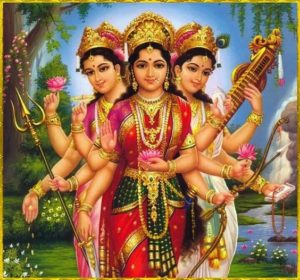
In Kerala and other places in India, the first three nights of worship are dedicated to Durga (the invincible), the next three to Lakshmi (Goddess of prosperity), and the final three to Sarasvati (Goddess of learning). Durga, also celebrated as her incarnation of Kali, helps us to destroy and remove the negative tendencies in our minds and hearts, freeing us from the obstructions to our spiritual and material pursuits. Lakshmi helps us to cultivate positive qualities like compassion and devotion, and leads us towards both spiritual and material prosperity. Sarasvati assists us in attaining knowledge and wisdom, through the illumination of our consciousness. She aids in awakening sattva, the quality of purity, and the flow of prana, the vital breath. After removing inner and outer obstacles and cultivating prosperity through virtuous qualities, our devotion, service, and practice help us to attain a state of peace, bliss, and oneness.
Sarasvati-Lakshmi-Kali/Durga
In the Kali Kula (Kali school of worship) in northeastern India, Sarasvati is worshiped on the first three nights, followed by Lakshmi on the next and then Kali/Durga on the last three. Sarasvati, Lakshmi, and Kali/Durga (Kali emerged from Durga) are also known as the consorts of Brahma, Vishnu, and Shiva. The Goddesses, therefore, provide the shakti to the cosmic processes of creation, preservation, and death (transformation), similar to their male counterparts. Consequently, worship in this manner is dedicated to the cycles of life and Mother nature, through birth, then sustenance, then death. Death is not a complete stop, but allows for the regeneration of energy into a new cycle once again.
9 Forms of Durga
Throughout India, the nine nights of Navaratri are often dedicated to 9 different incarnations of Durga, allowing the worship of many different aspects of Shakti in a gradual evolution. You can read the stories and significance of these 9 goddesses here (or click on Goddess name below), or a more a brief introduction, here:
“Daughter of the mountain”; creative energy, muladhara (root chakra), awakening; Awaken your connection with Goddess today or initiate a new venture, calling on Shailputri for new beginnings.
The ascetic; tapas, discipline, devotion, strength, wisdom, creative abundance; Good day for fasting and meditation, connection with svadhistana (sacral chakra).
Warrioress; protection, courage, grace, manipura (solar plexus); Destroy your internal obstacles by offering them to Chandraghanta.
4. Kushmanda (September 23rd)
Creatrix of the “cosmic egg”; strength, health, happiness, success, relationships; Connect with the vital Sun energy and the anahata (heart chakra) today.
“Mother of Skanda/Kartikeya”; motherly love, nourishment, protection, purity; Call on divine truth through the vishuddha (throat chakra), invoking Skandamata to lead you towards victory.
6. Katyayani (September 25th)
Warrioress who destroyed Mahishasura (the buffalo demon); victory, devotion, strength, removing obstacles; Meditate on these qualities of Goddess through the ajna chakra (third-eye) today.
7. Kalaratri (September 26th)
“Dark/black night,” representing a fierce form of Durga/Kali; darkness, death, surrender, dissolution of pain; Connecting with the sahasrara (crown chakra), remember that Divine Mother offers love, compassion, and many blessings even in hard times. Even in the midst of apparent darkness, and helps us to go beyond the boundaries of the material body-mind and connect with spirit.
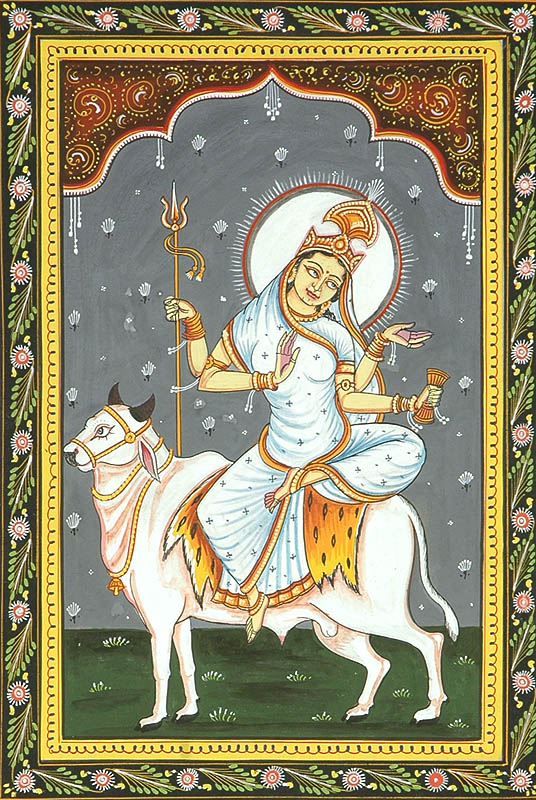 8. Mahagauri (September 27th-28th)
8. Mahagauri (September 27th-28th)
“Great white goddess”; detachment, purification, renewal, protection, virtue; Through detachment and devotion, we emerge purified, shining and radiant after surrendering in the dark night. Rejuvenative herbs and foods are good today.
Goddess of “siddhis”; magical, spiritual or mystic powers and blessings, fulfillment of desires, devotion, divine union; Invite Goddess to reveal her presence to you everywhere and in every moment.
Personal Practice Ideas for Navaratri
If possible, it is great to reduce our workload and gather with community at local temples or places of worship. We can also create a little time and space at home and conduct some personal practices to celebrate Goddess energy. Dive into your own heart to connect with the inner Goddess in the ways that resonate most with you! Here are some ideas to do at home or with a group throughout the nine nights of Navaratri:
Altar
Create a sacred space, a Durga altar, or a Goddess altar. Even if you already have one, you can refresh it in some way or rearrange it specifically for Navaratri. Include images or statues of the Goddess(es) you have a relationship with. This could be according to one of the groups of forms above.
Invocation
Even if you don’t have much time, dedicate at least a few minutes each day to connecting with the Divine Mother in front of your altar, calling her energy into your life and being.
Journal
Write in your journal about what qualities of Goddess you perceive and connect with. What aspects would you like to strengthen or to cultivate more deeply? Write any and all prayers and offer them to the form of Goddess that appeals to you.
Light
Offer light to illuminate Goddess’s power, helping her to shine more brightly into the world and your life. You can light a candle by the altar and keep it burning when you’re at home. You can even keep an electronic tealight on symbolically when you are away.
Flowers/Grains
Offer flowers or grains (even a small dish of dried rice) to celebrate Devi in the form of mother nature, fertility, the abundance of the harvest, and the cycle of life.
Offerings
Offer incense, bells, water, or food if you feel called, by placing it on the altar, or mentally offering it to Goddess throughout the day. You can also offer something symbolic of your own work or practice, whatever you have been cultivating for harvest through the year. In offering this you surrender the fruits of your efforts to the Divine Mother.
Fasting
Some people choose to fast in some variation, if this is something you have practiced before. This might include fasting during the day, fasting with only milk or fruit, or abstaining from alcohol and non-vegetarian foods during Navaratri.
Chanting
Chanting the Devi Mahatmyam, a verse to the Goddess, is a common practice during the nine-night festival. You can also chant another Goddess mantra or songs that are special to you and your relationship with Devi.
Jai Ma Durga!
Personal Vedic Astrology readings and forecasts are available Here.
Did you like Maha Navaratri 2017? Please Like, Comment and Share!
Save
Save
Save
Save
Save
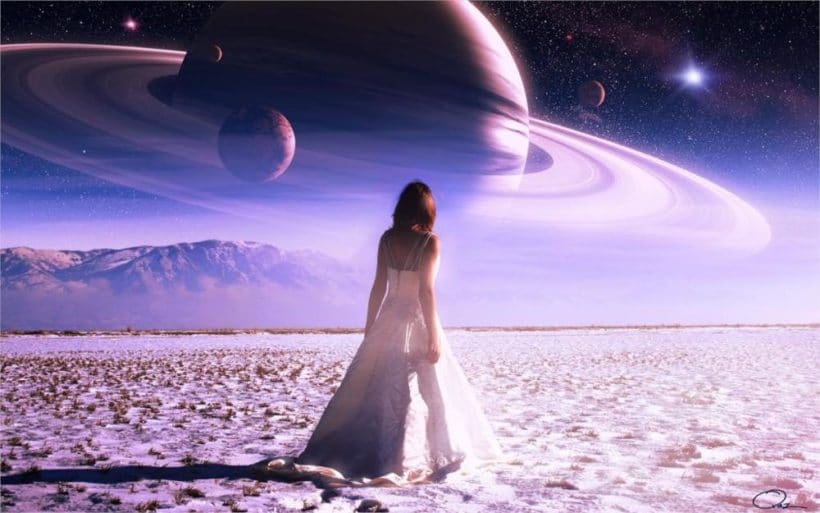
by Somya Devi | Sep 18, 2017 | Astrology, Conjunctions, Holy Days, Planets Changing Signs
New Moon in Virgo
The new lunar cycle begins Tuesday, September 19th, at 10:30 pm PDT, with Sun and Moon in sidereal Virgo. After a couple of months full of a lot of emotion and fire with many planets (and eclipses!) in Cancer and Leo, we have a chance to ground out a little bit more under the influence of earth-sign Virgo. Virgo is ruled by Mercury, the planet of the intellect, which brings a more practical and impartial nature to our energies this month. There is opportunity for curiosity and learning. The cycle begins in the Vedic nakshatra called Uttara Phalguni, which reminds us to take time in relaxation in order to re-kindle our productive energy.
The placement of Mercury and the nodes at the time of the Dark Moon, however, continue to make for a strong amount of “shadow” and subconscious energy to be present. Mercury, the lord of Virgo, will be in the 12th house from the Sun and Moon, and joining closely with Mars, showing a lot of intensity in the subconscious and potential for feeling disconnected. This New Moon also occurs under a full kala sarpa yoga, an alignment in which all seven planets are in between the two nodes of the Moon, Rahu and Ketu, in the cosmic circle.

Kala Sarpa
The kala sarpa yoga can be translated as “black snake” or “serpent of time.” The Moon transits the entire zodiac each month, so for two weeks of each month Moon will be on the other side of this axis, breaking the kala sarpa yoga, but for half of the month all planets will fall on one side of the “black serpent.” This will occur frequently over the next several months, when all seven planets will be situated to one side of the nodal axis (see photo) for half the month. The Moon transits the entire zodiac each month, so for two weeks of each month Moon will be on the other side of this axis, breaking the kala sarpa yoga, but for half of the month all planets will fall on one side of the “black serpent.”
When this alignment occurs, more of the shadowy and subconscious energy represented by the nodes is present. We may expect to be more introverted during this time, but it is also possible that more disruptive events can occur. People who are born under this alignment tend to have many “heavy” experiences throughout life. There can still be many positive and auspicious events during this time as well (or for those born under a kala sarpa yoga), but they tend to come after or despite some hardships or challenges.
Look for this yoga to occur for half the month from now through January of 2018. We experienced a similar occurrence last year (2016) from roughly September through January. This doesn’t happen every year, but we happen to be in a time where both Jupiter and Saturn, the slower-moving planets, are both to one side of the nodal axis. Thus this alignment occurs when the faster-moving planets, Sun, Mars, Mercury, and Venus, (plus Moon for half of each month) are also on one side of the axis.
Navaratri
Thankfully, there is a wonderful opportunity at hand to get in touch with the shadowy, subconscious energy of the nodes, through ritual worship and practice offered by Navaratri, the “nine-night” festival of the Goddess, which begins on the first day of this lunar cycle. This is a Hindu festival dedicated to worshiping the Goddess, Devi, in her many forms, for nine days and nights. As the night represents darkness and ignorance, we pray to her to help reveal and remove our shortcomings, bestow blessings, and confer wealth and knowledge. We face the darkness and call on the Divine Mother to remove it and let the atman, or the pure divinity within each of us, shine forth.
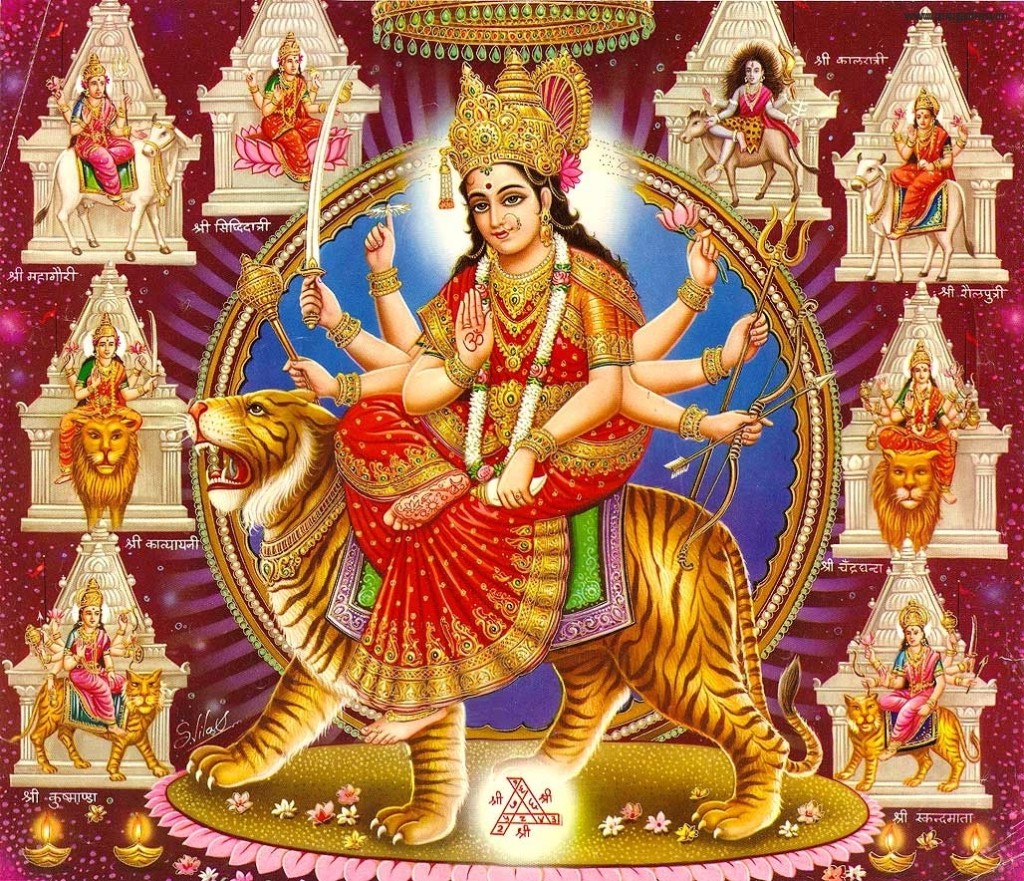 Navaratri worship can include creating a special altar to the Goddess, and making daily offerings including flowers, food, incense, light (a flame), ghee, as well as prayer, meditation, mantras and bhajans (devotional songs). The Devi Mahatmya (a.k.a. Chandi Path), the story of Durga, is a traditional text to read throughout this festival. Occurring in the fall-time in India and the northern hemisphere, this Navaratri also coincides with the harvest season, and is a time to give thanks for the abundance of the harvest and pray that it carries us through the winter season.
Navaratri worship can include creating a special altar to the Goddess, and making daily offerings including flowers, food, incense, light (a flame), ghee, as well as prayer, meditation, mantras and bhajans (devotional songs). The Devi Mahatmya (a.k.a. Chandi Path), the story of Durga, is a traditional text to read throughout this festival. Occurring in the fall-time in India and the northern hemisphere, this Navaratri also coincides with the harvest season, and is a time to give thanks for the abundance of the harvest and pray that it carries us through the winter season.
In many places, the first three nights of Navaratri are dedicated to Goddess in the form of Durga or Kali, warrior goddesses who help us to cleanse our impurities, the next three to Lakshmi, goddess of prosperity and devotion, and the last three to Sarasvati, goddess of wisdom. In other traditions, there are nine different forms of the Goddess honored on each of the nine days and nights. Be sure to follow me to receive daily updates throughout the festival!
Nodes Have Changed Signs
Since the onset of the eclipse cycle in early September, the nodes, Rahu and Ketu, have fully transitioned from the Leo-Aquarius axis to the Cancer-Capricorn axis. This completes one year-and-a-half transit as it begins another. From now through March of 2019, we will experience Rahu in Cancer and Ketu in Capricorn. The obsessive, insatiable Rahu in Cancer will cause us to experience a heightened state of emotionality throughout this time, with perhaps overwhelming sensitivity at times. The confusion of the nodes impels us to take time to get a better understanding of our hearts, and much will be revealed around the eclipse cycles that come in January-February 2018, July-August 2018, and January-February 2019.
With Ketu now transiting sidereal Capricorn, we will have to observe our shadows in the way that we balance our emotional nature with our practicality. Ketu in Capricorn could make us resistant to taking responsibility and practical steps for the future, but he will eventually raise self-awareness around any challenges we have here. We can be very self-critical in the area of Ketu’s transit, which will also affect each individual where Capricorn falls in the natal chart. Conversely, we may encounter impatience, restlessness, and even lust in the area of life indicated by Cancer in our natal chart, while Rahu transits there. I am happy to offer this Full Report and Forecast for Your Sign Here. (If you’re already on the free mailing list, you’ll be getting it in your inbox later today!)
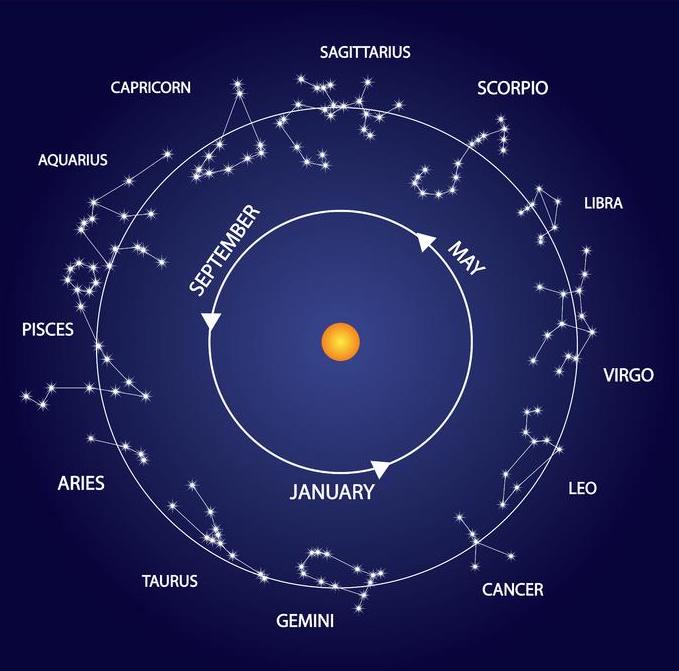
Jupiter in Virgo/Libra
Jupiter has technically transitioned zodiac signs recently, moving from sidereal Virgo’s into sidereal Libra’s designated slice of the pie-in-the-sky. Virgo is a much larger constellation than Libra, however, and in areas where abundant stars are visible just after sunset, one can see that Jupiter is still traversing the constellation of Virgo. The two do not each take up 30° of the 360° ring of the zodiac, in real observational terms, but rather Virgo takes up more than that portion while Libra covers less. Thus, we may be beginning to feel some energy of Jupiter in Libra (more inspiration for harmony, compromise, and the arts), I believe we are still experiencing a strong quality of Jupiter in Virgo (elevating our desire for organization of life’s details).
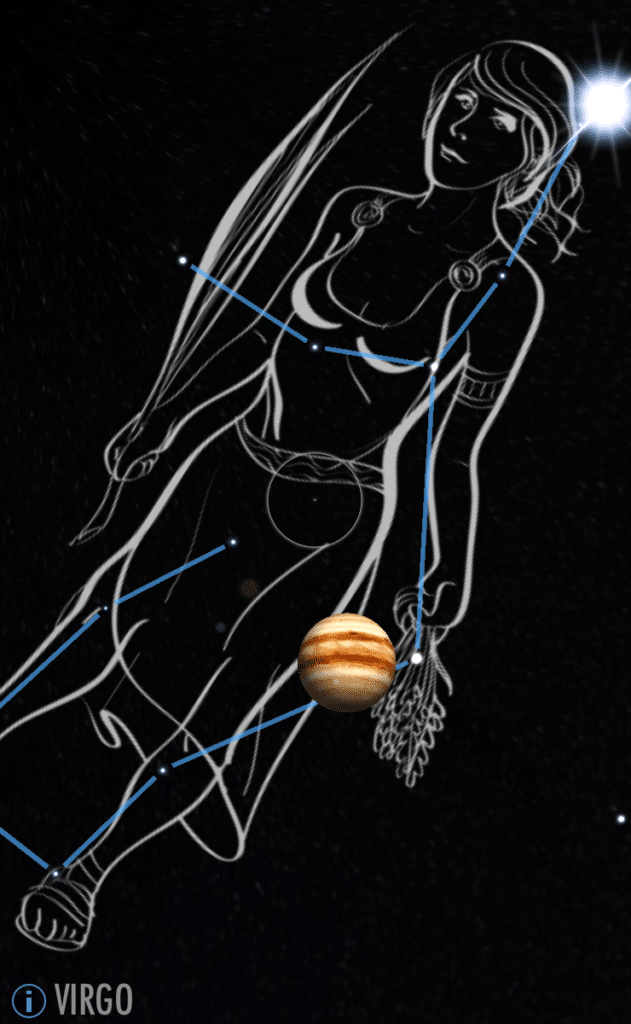 Also remember, most Western astrologers will say that Jupiter has been in Libra for the last year already, which can cause some confusion. That is based on the tropical zodiac, based on the seasons. Now is a great example of how the tropical zodiac does not correlate with the observable position of the planets and constellations as we see them from earth.
Also remember, most Western astrologers will say that Jupiter has been in Libra for the last year already, which can cause some confusion. That is based on the tropical zodiac, based on the seasons. Now is a great example of how the tropical zodiac does not correlate with the observable position of the planets and constellations as we see them from earth.
In the Vedic zodiac, Jupiter is still considered to be in the constellation of Chitra, which bridges the designations of Virgo and Libra. This nakshatra correlates with the star called Spica within Virgo (which Jupiter is closely conjunct at the moment), and translates as “the brilliant,” as it is one of the brightest stars in the sky. It is the sign of the celestial architect, and does bring forth a strong artistic quality. This is, therefore, a good time to allow your artistic inspiration to shine through, especially through both skillful and intelligent endeavors.
Mercury, Mars and Venus in Leo
Mercury, Mars, and Venus are all transiting sidereal Leo now. Venus in Leo can cause us to bring forth a lot of “me-first” in relationships, while the proximity of Mars and Mercury in this fire sign can lead to arguing, so be especially aware of these tendencies this month. The three are all catching an aspect from Saturn, now moving forward in direct motion in Scorpio, so that could help to add some mature caution to our impulses.
Save
Save
Save
Save
Save
Save
Save
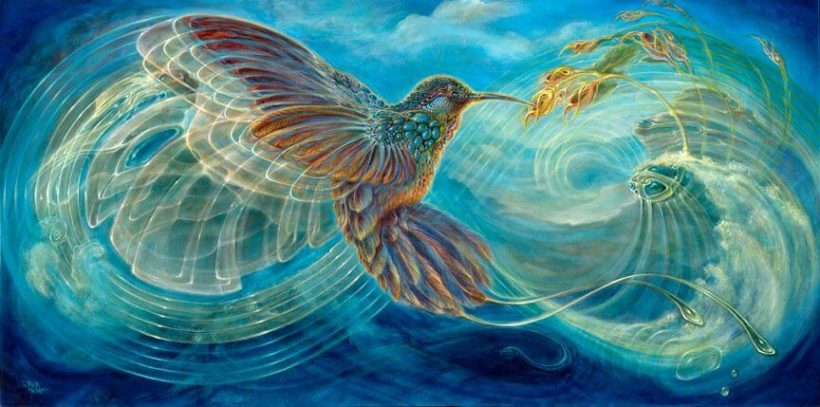
by Somya Devi | Sep 5, 2017 | Astrology, Conjunctions, Eclipses, Events, Planets Changing Signs, Retrograde
Title Photo by Martina Hoffman
Full Moon in Aquarius in Shatabisha Nakshatra
The Full Moon in Aquarius in Shatabisha nakshatra is happening tonight! The Moon reaches peak fullness at 12:03 am (just after midnight) Pacific time on September 6th, in the middle of sidereal Aquarius, in the nakshatra known as Shatabisha.
Aquarius and Leo
 The Aquarian full Moon draws our mind more towards the collective good, and how we can be of service to society, in contrast to the Sun, Mars, and Mercury in Leo, who draw the emphasis to personal power. The Full Moon is a time to harmonize the energy of the two sides of this zodiacal axis, and utilize our Aquarian side to reflect upon service. How we can achieve this while actually standing in our own power and using it for good at the same time?
The Aquarian full Moon draws our mind more towards the collective good, and how we can be of service to society, in contrast to the Sun, Mars, and Mercury in Leo, who draw the emphasis to personal power. The Full Moon is a time to harmonize the energy of the two sides of this zodiacal axis, and utilize our Aquarian side to reflect upon service. How we can achieve this while actually standing in our own power and using it for good at the same time?
Full Moon Medicine
Shatabisha, the Vedic star-sign where this full Moon peaks, is a powerful nakshatra for healing of all kinds. Known as the “hundred medicines” or the “hundred physicians,” the energy here drives us to explore alternative forms of healing. This includes our quest for self-healing and also the tools that we might use to help to heal others. The deity for this nakshatra is Lord Varuna, the god of the cosmic waters. Let us pray for healing waters as opposed to those that have been so destructive of late!
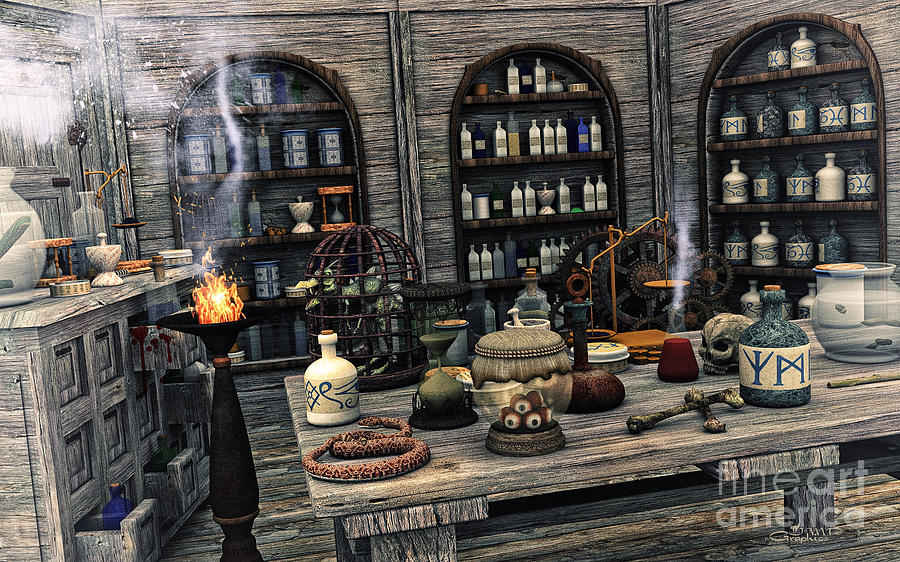 After the intense solar eclipse that began this cycle on August 21st, we have seen a continued onslaught of natural disasters across the globe, and this is a potent time to reach into your apothecary for whatever medicines can help. This might mean different herbs or foods as medicine, or it could also include a practice such as dance or meditation. With the pleasure-loving Venus joining Rahu, be careful of over-indulging, especially if you have a tendency to abuse medicines or drugs.
After the intense solar eclipse that began this cycle on August 21st, we have seen a continued onslaught of natural disasters across the globe, and this is a potent time to reach into your apothecary for whatever medicines can help. This might mean different herbs or foods as medicine, or it could also include a practice such as dance or meditation. With the pleasure-loving Venus joining Rahu, be careful of over-indulging, especially if you have a tendency to abuse medicines or drugs.
Rahu, Ketu, & Eclipse Aftermath
The nodes are now on the cusp of Leo-Cancer and Aquarius-Capricorn, respectively. You may have seen some discrepancy among Vedic astrologers in citing the date of Rahu and Ketu’s transition from the Leo-Aquarius axis and into Cancer-Capricorn. This has to do with subtleties in the astronomical calculation methods and software settings involved. It may appear as if the nodes crossed the imaginary zero-degree mark on August 17th (as I’ve cited previously) according to some calculation methods, while other astrologers are still awaiting that change to occur, later in September.
Whether the nodes have technically crossed that imaginary line or not, they are still near the “cusp” of both sign-axes either way. Whenever planets are on the cusp of two signs, they are not strongly established in the energy of either sign, but might actually behave with influences from both of the two signs. Similarly, if someone was born with the ascendant close to the cusp of two signs, they may resonate with the energies of both signs to a degree, rather than one distinctly. Thus, Rahu is now exerting his harsh force (more powerfully because of the recent eclipse) with some energy of Cancer and some energy of Leo.
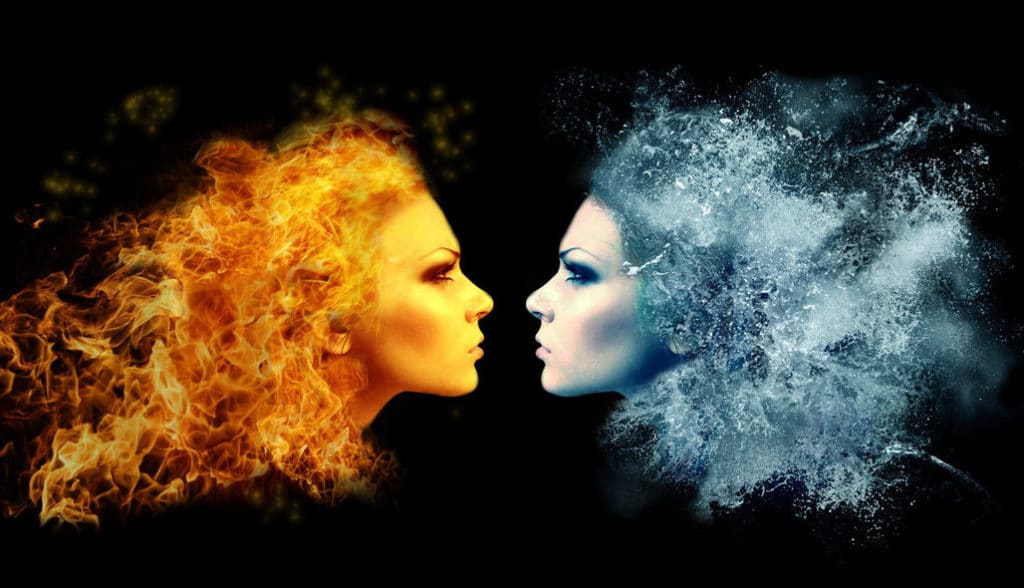
Fire vs. Water by FelipeS4rg
With all of the recent flooding across the world, I believe we’re strongly seeing the energy of Rahu in Cancer coming through. I predicted the “floodgate of the heart” would open during this transit, with perhaps some overwhelming emotions arising. With this recent bout of flooding surrounding the Great American Eclipse on August 21st, there is a strong presence of Rahu-in-Cancer energy visible. Simultaneously, with the multitude of forest fires raging, and the continued intensity of the political arena, we are also still experiencing the Leonian influence on Rahu. Rahu, the demon planet of intensity, appears to be rearing his (detached) head with both the water-power of Cancer and the fire-power of Leo. This influence is acutely felt across the US, where he showed his shadow in full power to begin this Moon cycle.
Mercury, Venus, Saturn & Jupiter
Mercury turns direct today! It will take him a few days to pick up forward-momentum, however, so be aware of potential stagnancy in communication, and the ironing out of details and logistics.
Venus, in my calculations, is now joining Rahu in the open-hearted sign of Cancer. This is a tough position for the planet of pleasure and compromise. Proximity to Rahu could cause us to over-indulge in sensory pleasures, while Venus is already feeling a bit challenged in the sign of the Moon. The Moon and Cancer compel us to open our hearts and bestow loving compassion on everyone. An intelligent Venus helps us to find a balance in the give-and-take of relationships, so with Venus in Cancer we have a tendency to open our boundaries too far, and present the possibility of being (or feeling) taken advantage of. Watch your boundaries in relationships over the next few weeks while Venus transits Cancer, approaching and passing Rahu.
Saturn stationed and turned direct on August 25th, and is now making his final traverse of Scorpio for the next 27 years. This is the home stretch of Saturn’s return and Sade Sati for some people, and for everyone it is the time to really reflect on how we have re-committed to our personal transformation over the past three years.
Jupiter is getting ready for another major transit as well, beginning on September 11th when he will cross the imaginary line between Virgo and Libra. For the past thirteen months we have experienced the influence of Jupiterian expansion, luck, and grace in the style of Virgo, in the house indicated by Virgo in our charts. Once Jupiter settles fully into Libra, we will experience this effect in that area of our lives. This could add to some more collective balance and harmony in the world, as we begin to think about applying our principles in a more fair and balanced way. It will also have positive expansive influences on Libra-, Aquarius-, and Gemini-rising people in general. Each sign will gain Jupiter’s positive effects in a specific area of life, so look out for the Jupiter-in-Libra forecast coming this month! (Sign up for the free mailing list here if you aren’t already on it…you’ll also get last year’s free Jupiter-in-Virgo e-book if you want to take a look at where this transit already affected you).
Kala Sarpa
The last two weeks since the eclipse had us in a quasi-Kala Sarpa yoga alignment, with all the planets joining or on one side of the Rahu-Ketu axis. (This is using the calculation that puts Rahu in Cancer.) This intensifies everything, including those water-fire effects of the recent eclipse over the US. I’m hoping that the next few weeks will have a lessening of intensity around these themes, especially as the Moon begins his waning journey tomorrow .
If you’d like to see how all of these many influences are affecting your personal natal chart, you can schedule a personal reading with me, Here!
Praying for peace, healing, and blessings for all.
Save











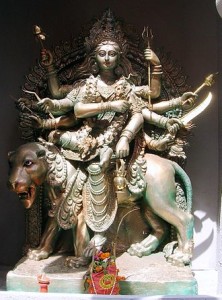



 Navaratri worship can include creating a special altar to the Goddess, and making daily offerings including flowers, food, incense, light (a flame), ghee, as well as prayer, meditation, mantras and bhajans (devotional songs). The Devi Mahatmya (a.k.a. Chandi Path), the story of Durga, is a traditional text to read throughout this festival. Occurring in the fall-time in India and the northern hemisphere, this Navaratri also coincides with the harvest season, and is a time to give thanks for the abundance of the harvest and pray that it carries us through the winter season.
Navaratri worship can include creating a special altar to the Goddess, and making daily offerings including flowers, food, incense, light (a flame), ghee, as well as prayer, meditation, mantras and bhajans (devotional songs). The Devi Mahatmya (a.k.a. Chandi Path), the story of Durga, is a traditional text to read throughout this festival. Occurring in the fall-time in India and the northern hemisphere, this Navaratri also coincides with the harvest season, and is a time to give thanks for the abundance of the harvest and pray that it carries us through the winter season.
 Also remember, most Western astrologers will say that Jupiter has been in Libra for the last year already, which can cause some confusion. That is based on the tropical zodiac, based on the seasons. Now is a great example of how the tropical zodiac does not correlate with the observable position of the planets and constellations as we see them from earth.
Also remember, most Western astrologers will say that Jupiter has been in Libra for the last year already, which can cause some confusion. That is based on the tropical zodiac, based on the seasons. Now is a great example of how the tropical zodiac does not correlate with the observable position of the planets and constellations as we see them from earth.
 The Aquarian full Moon draws our mind more towards the collective good, and how we can be of service to society, in contrast to the Sun, Mars, and Mercury in Leo, who draw the emphasis to personal power. The Full Moon is a time to harmonize the energy of the two sides of this zodiacal axis, and utilize our Aquarian side to reflect upon service. How we can achieve this while actually standing in our own power and using it for good at the same time?
The Aquarian full Moon draws our mind more towards the collective good, and how we can be of service to society, in contrast to the Sun, Mars, and Mercury in Leo, who draw the emphasis to personal power. The Full Moon is a time to harmonize the energy of the two sides of this zodiacal axis, and utilize our Aquarian side to reflect upon service. How we can achieve this while actually standing in our own power and using it for good at the same time? After the intense solar eclipse that began this cycle on August 21st, we have seen a continued onslaught of natural disasters across the globe, and this is a potent time to reach into your apothecary for whatever medicines can help. This might mean different herbs or foods as medicine, or it could also include a practice such as dance or meditation. With the pleasure-loving Venus joining Rahu, be careful of over-indulging, especially if you have a tendency to abuse medicines or drugs.
After the intense solar eclipse that began this cycle on August 21st, we have seen a continued onslaught of natural disasters across the globe, and this is a potent time to reach into your apothecary for whatever medicines can help. This might mean different herbs or foods as medicine, or it could also include a practice such as dance or meditation. With the pleasure-loving Venus joining Rahu, be careful of over-indulging, especially if you have a tendency to abuse medicines or drugs.